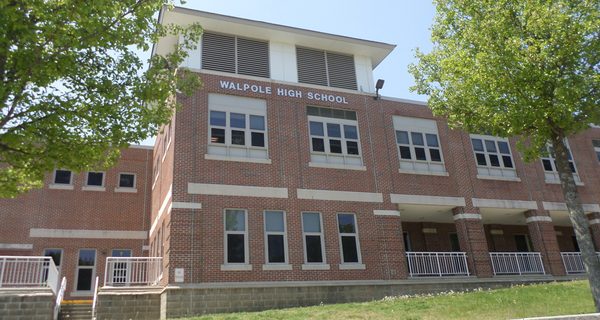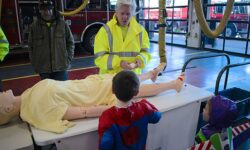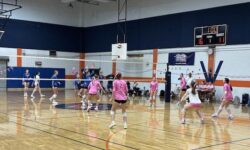By James Kinneen
Hometown Weekly Reporter
On August 6, the Walpole School Committee unanimously voted to attempt the hybrid model of school reopening in the fall. While the committee emphasized fluidity and adaptability, they thoroughly outlined the model and tried to respond to possible issues that could arise.
The first thing the committee did was note the results of a survey of Walpole parents. Using a one to five scale with one meaning “you definitely would allow,” and five meaning “you definitely would not allow,” parents were asked “how likely are you to allow your child to return to in person learning if…” Out of 2,058 respondents, when asked if they’d be comfortable letting their kid return to school with six feet of social distancing and masks, only five percent of people said they were at a “one,” 10 percent said “two,” 18 percent said “three,” 23 percent said “four”, and 44 percent said “five.”
When asked the same question, but if only three feet of distancing could be accommodated, the numbers didn’t change all that much. Eight percent said they were a “one”, 12 percent were a “two,” 18 percent were a “three,” 22 percent were a “four,” and 40 percent of respondents were a “five.”
As of right now, the plan is for the school year to run from September 14 to June 15. The hybrid system will split all kids from grades one to twelve into two groups called “cohorts,” decided not totally, but mostly, by last names, with A-J being one group and K-Z being the other. The committee asked the community not to make childcare or work schedules until their children's cohorts are confirmed. Group A will go to school on Monday and Tuesday (remote Wednesday, Thursday, Friday), while Group B will go to school Thursday and Friday (remote Monday, Tuesday and Wednesday). On Wednesday, both groups do remote learning only.
When their cohort is not in class and is instead learning remotely, students will be responsible for “following the school schedule, attending classes remotely, and completing asynchronous work given by their teachers.” While there are many definitions online, asynchronous work tends to mean not being connected to a teacher in real time (a prerecorded lecture you can watch appears to be the most cited example). The remote learning on Wednesdays will be synchronous with a teacher present.
In high school, classes are going to be longer to limit passing in the hallways, and so kids will only have to focus on four classes. Teachers will interact for the first five to ten minutes of class with the kids at home, but teachers will not be streaming the entire length of their classes. This applies to the middle school level, as well.
“There will be some repetition,” the committee noted, but the Monday/Tuesday lessons are not going to be exactly the same as those on Thursday/Friday.
In the hybrid model, remote students are to log into their teachers virtual classroom at the beginning of each period, either through Zoom or Google Meet. Attendance will be taken for the remote cohort kids, so they have to check in with the teacher and make sure they know what they’re supposed to be doing. Teachers will not be streaming the class in its entirety for the remote students.
In middle school, kids are being split into “learning pods” of around eight to 12 people and leveled classes in both ELA and math have been eliminated. Students won’t be using lockers, to limit hallway time - instead, their belongings will be kept in their pod classroom and teachers, not students, will be the ones that switch classrooms.
In elementary school, kids are assigned to their grade level classrooms. They’re going to be assigned Chromebooks and are responsible for bringing them to school, fully charged, every day. Kindergarteners will go to school in person every day but Wednesday.
For those choosing to go fully remote (that is, students whose parents opt not to send them for in-school learning despite the hybrid model), there isn’t yet a plan. DESE endorsed four programs, two are fully synchronous, two are asynchronous. Walpole is looking at all those options, while also considering if they can have a model that can be done strictly by Walpole School staff (perhaps a teacher with a health condition who can’t be in a classroom could teach the remote kids).
Walpole has some issues with figuring out exactly what they’re going to do about the kids who choose the remote option. There is a price difference (that the district would deal with, not the students) which needs to be factored in. But the main reason the committee is struggling to commit to a plan is because they don’t know how many kids are opting for the fully remote option.
Unfortunately, many parents won’t commit to going fully remote without knowing what that option looks like. This creates a bit of a catch-22. Whatever program Walpole chooses will be at no cost to families that choose it as an option.
As for the classrooms themselves, in the hybrid model, classes will average about twelve kids, so HVAC systems should have an abundance of fresh air, since they’re designed for rooms with thirty kids inside. Schools will also have windows open, are adding fans to each room, and rooms without windows will get medical-grade HEPA filters. HVAC filters will also be changed more frequently - from once a year in the summer (the usual protocol) to three times a year.
The committee ordered clear masks, which are currently being used in ESY classes and are supposed to be used by staff members, like speech therapists, working with high-need kids. Schools are also planning to tell “social stories” to try and get kids to understand why they need masks. Preschool kids will be “strongly encouraged” to wear masks, while for everyone from pre-K to 12th grade, they are mandatory.
As for worries of parents attempting to hide a positive test, the Walpole Board of Health is told when there’s a positive COVID test in town, so that’s not really an option. As for transportation, those who take the bus will find one-kid-per-bench assigned seating - though anyone who can is encouraged to drive their own children to school.
For those children with a a positive coronavirus test, the least amount of self-isolation time before coming back to school is ten days.
While committee member Mark Breen called the hybrid plan the “least bad option,” it has been thoroughly outlined and presented well.
























